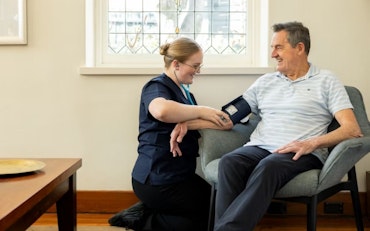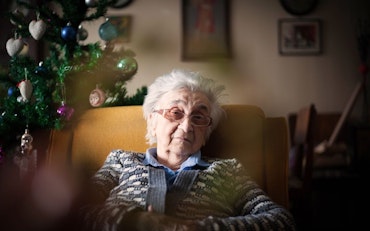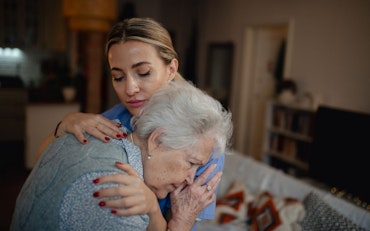Compassionate Parkinson’s home care: building strength, stability and support
SPONSORED — Parkinson’s disease always seems like a challenge to live with initially. It can be a struggle for the diagnosed and their loved ones, as if going uphill at first. Those early symptoms — the shaky hands, the stiffness and the fatigue that slowly creep in seem to be upsetting, to say the least.
![<p>Parkinson’s disease primarily affects older people. [Source: Rawpixel via iStock]</p>](https://agedcareguide-assets.imgix.net/news/articles/wp/Rawpixel__2205.jpg?fm=pjpg&format=auto&w=550&q=65)
Parkinson’s disease primarily affects older people. [Source: Rawpixel via iStock]
It is possible to maintain control and receive support to live independently. The goal of home care is not to cure Parkinson’s disease; rather, it is to create a life that accommodates it and to establish a safe environment for everyone to thrive.
Imagine it as a dance, a combination of patience, understanding and a lot of love.
Parkinson’s care at home: key principles
- Empathy and patience are the key to effective home care success. Remember, Parkinson’s affects everyone differently. It is a chameleon that changes colours throughout.
You should listen closely and try to respond kindly when there are mood swings or disengagement of physical ability. Be a sleuth in a way, reading the cues of your loved one within your home.
- Structure is your secret weapon; daily dinners, meds, movement and events that create a sense of comfort in an ocean of doubt. It’s about staying on track and avoiding an intense and overbearing feeling.
- Promoting self-sufficiency is an important task for creating independence. Simple actions, such as dressing themselves and walking without assistance, can significantly boost their confidence.
- Safety is also very important and your home should be considered a well-oiled machine, built to eliminate risk. You should consider installing rigid handrails to avoid frustration and falls.
A brightly lit home, mainly in the hallways and staircases, may also help improve home safety.
- You should communicate properly by speaking slowly and clearly, giving them plenty of time to respond.
- You should always acknowledge their frustrations and fears, ensuring they feel seen. Providing constant emotional support for both the patient with Parkinson’s and the caregiver is essential.
Shaky starts: navigating early symptoms
The first symptoms could be subtle, like a barely perceptible tremor or a touch of stiffness. Getting used to something can take time and that is okay. Focus more on the positives and consider what actions you can take next.
Consult doctors and find support services; knowledge is power. This early notion informs wise choices, resulting in soft changes at home.
To simplify your life, organise your clothes, choose easy-to-use utensils and use calendars or alarms to plan your day. Small changes can create a sense of satisfaction from the start.
Safe and supportive home environment
It is hard to overestimate the importance of creating a safe home setting in Parkinson’s care. Falls are avoidable, so preventative measures towards these potential accidents go a long way. Clear up pathways around the house, dispose of loose rugs and use a non-slip mat in the bathroom.
You should place bars in areas such as the bathroom and stairwell to prevent falls. Additionally, you should consider installing bright lights in the hallways and staircases, along with using nightlights in the bathroom to see at night. No matter how little these changes may be, they lead to an increase in confidence and hazard reduction.
Daily life and personal care
Living with Parkinson’s involves adapting daily activities to facilitate comfort. As the condition progresses, duties such as bathing and dressing become more difficult, so it’s important to factor that into your care plan.
Bathing
Use shower chairs and handheld showers for safer bathing.
Dressing
Choose clothing with easy-to-use fasteners.
Grooming
Utilise grooming tools with longer handles and non-slip mats.
You should always keep track of these small victories because they make them feel valued and confident.
Managing medications and health
Managing medications is crucial in home care, especially for those with Parkinson’s disease, as timing can be vital. Skipping doses can have serious consequences, so keep a close eye on their medication schedule.
Consider using pill sorters, phone alarms or marking your calendar to remind yourself when it’s time for their pills. Encourage open communication; if something doesn’t seem right, it’s important they speak up. These steps can make medication management much smoother.
Tag along with the person to the doctor’s office when possible. Share your observations about their feelings and behaviour and keep a notebook to record everything. This practice can be a lifesaver when situations take a turn for the worse.
Getting moving and working out
Light workouts and regular activities are essential for maintaining steady support. Moving fights stiffness and promotes mobility. Consider short walks, stretching, and low-strain exercises. Chair yoga, Tai Chi and dancing to your favourite tunes all work very well.
Exercise can also slow the progression of Parkinson’s and improve movement, posture and overall quality of life. A physical trainer can demonstrate safe routines tailored to each individual’s capabilities.
Even slowly completing household tasks can provide useful movement. Every little step counts, like dancing together in your living room, which can be a fun way to stay active and boost happiness.
Nutrition and well-being
Food is a major component of general well-being and digestion presents problems for many Parkinson’s patients. Eating foods rich in fibre — full of fruits, vegetables and wheat — helps to tackle this issue.
If swallowing becomes difficult, you should eat smaller meals, more frequently, because some people prefer five or six small meals a day, rather than three large ones. If food becomes difficult to eat, think about thick drinks or healthy smoothies as they can really save the day.
Incorporating proteins and quality fats at each meal will help maintain strong muscles and provide more energy and brain health. It is important for the body to consume enough water and food. This supports the body’s ability to manage treatments while remaining strong.
Adding mild herbs or spices can enhance the flavour of food that tastes a bit flat. Easy snack options like yogurt or fruit drinks provide additional nutrients between meals.
Emotional support and communication
Parkinson’s disease can impact mood and cognitive processes, making emotional support just as crucial as physical assistance. Feelings of worry and sadness often arise and can worsen symptoms.
It helps to encourage open discussions about their feelings, reassuring them that experiencing such emotions is part of being unwell and that it’s not their fault if they forget things or think slowly. This approach can help them feel heard and alleviate mental health issues.
Using short, simple sentences and allowing ample time for responses can also make a significant difference. Engaging in calming activities, like playing their favourite songs, reading stories or taking walks in the neighbourhood, can provide comfort. If symptoms worsen, consider seeking counselling or joining support groups.
Both the person with the illness and the caregiver need breaks, and outside support can ease emotional burdens. Engaging in activities such as keeping a daily gratitude journal or exploring creative outlets like painting or music can positively shift their mood.
Family, community and resources
Caring for someone who has Parkinson’s in a home setting becomes so much easier if you have support. You need to have family, friends or neighbours; even the simplest things, such as stopping by or grabbing some groceries and eating together, can lift everybody’s moods and really make a difference.
Plus, many places have Parkinson’s support groups for ill people and caregivers — you’ll get practical advice and friends who understand your feelings. Some neighbourhood centres have workout exercises or art classes adapted for people with Parkinson’s, which can be fun and social as well.
Don’t hesitate to ask your doctor or social workers around you about stuff such as therapy sessions or what respite services for caregivers are.
There is a cornucopia of charities and health groups that dispense support and information. For example, Parkinson’s Australia has a hotline, 1800 644 189, for answers and someone to talk to. Just keep in mind, asking for a hand is smart, not weak.
Self-care for caregivers
Taking care of someone with Parkinson’s is rewarding, but it can drain you completely. Caregivers should be vigilant for themselves as well. You can absolutely take some time off — get respite care, contact a relative or friend and have them take over for a while.
Continue seeing your own doctor, doing things you enjoy and spending time with your friends. Eating well, moving your body and getting enough sleep really count. A well-rested, healthy caregiver can make a major difference in providing the greatest possible support.
When you care for yourself, you are building up steam for a long haul. For instance, stealing 15 minutes a day of some easy activity, relaxing, e.g., reading or a quick walk — something non-stressful that you like, can juice up your energy levels and calm you down.
Planning with compassion
Parkinson’s is progressive, thus it’s important to look further ahead and plan for future needs. Although preliminary signs may seem to be under control, planning is a source of serenity in the long term. Genuine conversations on preferences — whether healthcare, changes in the house or emotional care — help everyone prepare together.
Care strategies can change over time, but it is good to have legal, financial and care decisions outlined from the start so this process is respectful of the person’s voice. It also relieves future stress among family members.
Start small, appoint a responsible person to make healthcare decisions, update the medication list and emergency contact and peer review plans regularly. Involvement and autonomy are encouraged with the inclusion of the Parkinson’s patient in these options.
It also encourages clarity; family members will know what to expect and not misunderstand each other. A care binder — documents, contacts and instructions to stay organised — is a simple but useful tool.
Keeping minds and hearts engaged
Emotional well-being is just as necessary as physical support. Gentle daily stimulation helps people with Parkinson’s. Music, easy puzzles, reading aloud and journaling are encouraged. These are activities that support memory, lift one’s spirits and relieve anxiety.
Find quiet moments for connection, such as a shared story, a good walk or a time for pets. The target is not productivity, but emotional nourishment; even passive involvement, such as hearing sounds of nature or one’s favourite tunes, is worth value and relaxation.
Never underestimate the power of small routines; a morning greeting, a cup of tea at lunchtime or an evening recitation of a poem becomes a stabilising ritual, a source of deep emotional stability.
Creative activities that foster connection
Creativity adds joy to routine and you can do things like painting, knitting or adapted gardening; let the person operate at his or her own pace. Use large handled brushes or soft clay in order to encourage easy movement.
Small group craft or storytelling can also create a sense of connection. Make photo albums jointly or record family reminiscences in writing. These common experiences serve to create a connection; not only that, they give an identity and a goal to life.
You can find gentle engagement, even on low-energy days, by watching an art video or colouring with pastel pencils. Rotate activities each week to keep things interesting and avoid monotony. Aim for joy; perfection is not the goal.
Conclusion
Winning in Parkinson’s care is not measured in leaps, but in small steps. Achievements such as crossing a room, finishing a cup of tea without assistance or smiling after a tough morning are moments to celebrate.
Recognising progress and praising effort strengthens confidence and supports the journey from loss to resilience. Caregivers also benefit from this positive reinforcement, as it fosters hope and helps them grow stronger emotionally.
Caring for someone with Parkinson’s is a journey. At first, it can be difficult and puzzling. However, time is helpful in that things can move from bad to normal. Taking care of them isn’t just about their condition; it’s also about figuring out how they can live a good life.
Each small win in the world and every moment of a shared life helps us understand how strong and special this journey is.










